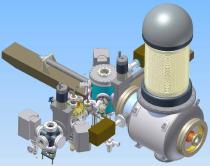ERL Research
Photoinjector

The ERL injector will produce 100 mA low-emittance beams.
The ERL is a single-pass machine which means the low-emittance beams must be produced at injection and not through synchrotron radiation damping. This puts demanding requirements on the electron gun used in the ERL. The injector will be a DC photoemission electron gun and will provide high-current, low-emittance electron beams.
The ERL photoinjector has been optimized in simulations and is now being constructed on-site at Wilson Laboratory. The ERL injection system also involves five superconducting niobium cavities to accelerate the beam from 500 keV to 15 MeV. Prototypes of these cavities are currently being optimized and fabricated at Cornell.
Particle Dynamics Simulations
The beam current in the ERL is limited by an unstable increase of ElectroMagnetic (EM) fields in the linac cavities. This is called the beam breakup (BBU) instability and is being studied here at Cornell. Theoretical and simulation studies of the BBU in the ERL are being developed, including the effects of a feedback system.
Other electromagnetic fields exert nonlinear forces on the beam. These fields come from a variety of sources including the individual bunch particles (space charge), the synchrotron radiation from one part of the bunch shining on another part (coherent synchrotron radiation), and the fields excited in the RF cavity (wake fields). All of these EM fields cause the small emittance of the electron bunches to be increased beyond a useful size for a high-brightness x-ray source. Mitigation techniques of these disrupting EM fields are being studied in simulations at Cornell.
 The ERL injector will produce 100 mA low-emittance beams.
The ERL is a single-pass machine which means the low-emittance beams must be produced at injection and not through synchrotron radiation damping. This puts demanding requirements on the electron gun used in the ERL. The injector will be a DC photoemission electron gun and will provide high-current, low-emittance electron beams.
The ERL photoinjector has been optimized in simulations and is now being constructed on-site at Wilson Laboratory. The ERL injection system also involves five superconducting niobium cavities to accelerate the beam from 500 keV to 15 MeV. Prototypes of these cavities are currently being optimized and fabricated at Cornell.
The ERL injector will produce 100 mA low-emittance beams.
The ERL is a single-pass machine which means the low-emittance beams must be produced at injection and not through synchrotron radiation damping. This puts demanding requirements on the electron gun used in the ERL. The injector will be a DC photoemission electron gun and will provide high-current, low-emittance electron beams.
The ERL photoinjector has been optimized in simulations and is now being constructed on-site at Wilson Laboratory. The ERL injection system also involves five superconducting niobium cavities to accelerate the beam from 500 keV to 15 MeV. Prototypes of these cavities are currently being optimized and fabricated at Cornell.
